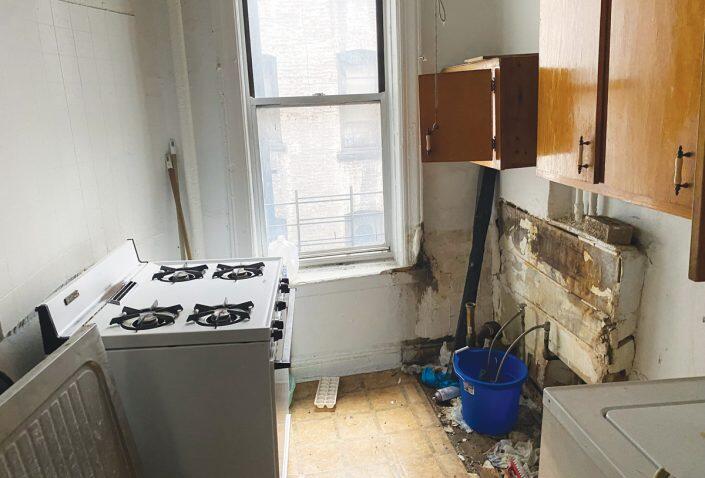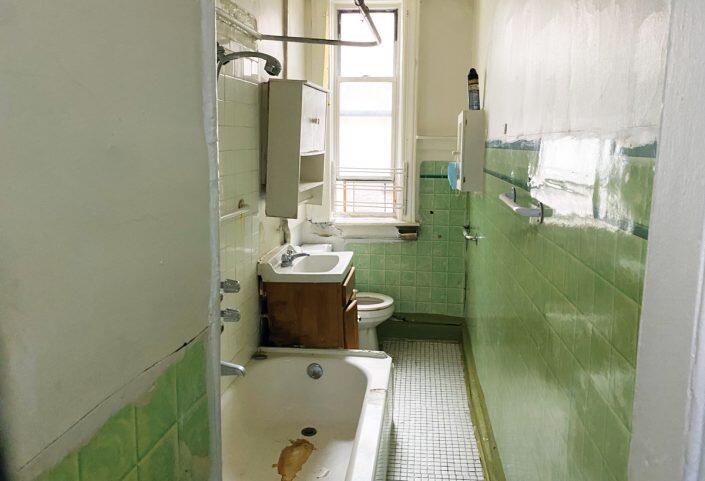Trending
In housing-starved NYC, tens of thousands of affordable apartments sit empty
Landlords blame the state’s rent law for making repairs a money-losing proposition; lawmakers don’t believe them.

In a Washington Heights apartment building, vacant units are littered by the forsaken belongings of tenants. A wall decal in one reads “I love God” in bubble letters. In another, a dresser gathers dust beneath a boarded-up window. In a third, abandoned possessions poke holes through trash bags.
The abandoned items were left by tenants of rent-stabilized apartments that now sit unoccupied and unavailable in a city desperately in need of low-cost housing.
Landlord David Eshaghoff recalls a simpler time, before state lawmakers made renovating and renting these units out a money-losing proposition. Eshaghoff’s empty apartments — about a dozen of his 200-unit portfolio — need repairs. Collapsing ceilings, disintegrating plumbing and shoddy electrical work render them uninhabitable.
But he said that because of New York’s rent law, there is no economic rationale to fix them — even if he could afford to.
Landlords’ plight
The Housing Stability and Tenant Protection Act, a sweeping rent reform passed by the state Legislature in 2019, dramatically limited landlords’ ability to increase rents on stabilized apartments. The measure ended the vacancy bonus that had allowed owners to raise rents 20 percent when stabilized units became unoccupied. It also reduced to $15,000 over 15 years the renovation costs that landlords can recover by hiking rents.
Eshaghoff estimates that it would cost anywhere from $70,000 to $120,000 to renovate one of his empty apartments — far more than the law allows him to recoup by renting them out afterward.
“Nobody really, in this day and age, wants to live in the product that currently exists,” he said. “You can only put so much lipstick on a pig. Eventually it’s gotta go for slaughter.”
Some advocates blame landlords for letting the units deteriorate, but many apartments were occupied for decades by tenants who did not want to leave temporarily to allow improvements that, under the old law, would raise their rent permanently.
Owners of stabilized apartments across the city say the renovation provisions — which also curtailed rent increases for building-wide improvements such as new roofs, boilers and elevators — and other changes in the 2019 rent law have not only worsened the housing shortage but jeopardized their business models.
Some have decided to cut their losses. Rosedale Management, a three-generation family business, unloaded 10 of its 13 buildings in the year and a half after the law passed. Two of the properties needed new elevators — a $600,000 job altogether. Unable to finance those repairs, Rosedale decided to sell in a down market.
“That was solely due to the changes in the rent laws,” a spokesperson for the firm told The Real Deal last summer. “There was absolutely no way to break even.”
Meanwhile, owners claim rising expenses such as maintenance, insurance, utilities and taxes have pushed the operating costs of some rent-stabilized buildings above what they can legally charge tenants.
The Community Housing Improvement Program, a landlord group, calculated that monthly operating costs now average $1,548 per unit. The median monthly rent for a stabilized apartment in the city, according to the Rent Guidelines Board, is $1,422.
Vacant but unavailable
In April, CHIP launched a campaign to call attention to the city’s unrentable housing stock. The group estimated that 20,000 rent-stabilized apartments in the city were empty because renovations were not economically feasible.
In May, the city’s Department of Housing Preservation and Development released a more staggering number: nearly 43,000 vacant but unavailable units. It was a galling figure, given the city’s homelessness problem, soaring rents and dearth of affordable housing.
HPD’s survey found that the vacancy rate among affordable units, defined as renting for less than $1,500, fell to below 1 percent last year, the lowest in three decades. Between 2017 and 2021, the city lost 96,000 low-cost units but gained over 100,000 with monthly asking rents above $2,300.
As the market tightened in the past year, the median rent for market-rate apartments increased 21 percent. The median rent in Manhattan set an all-time record for the sixth consecutive month in May.
Meanwhile, the city’s homeless population is at a level not seen since the Great Depression, according to the advocacy group Coalition for the Homeless. Every night, about 60,000 New Yorkers — including more than 15,000 children — sleep in shelters. The city’s vacant rent-stabilized units could house them all.

These vacant units in David Eshaghoff’s buildings remain off the market because renovation and operating costs far exceed what the owner can legally recover in rent.operating costs far exceed what the owner can legally recover in rent.
The vacancy survey identified various reasons why those stabilized units sit vacant, but did not break down the total. Some are undergoing renovations or being kept off the market until an apartment next door becomes vacant, which allows landlords to combine them and set a new rent. Others may fit the narrative landlords describe: They’re uninhabitable and awaiting repairs.
“This is only going to keep getting worse,” said Jay Martin, CHIP’s executive director. “We’re talking about a very aged housing stock across the city.”
A losing game
Helen Greenberg, a multigenerational owner of two buildings in Lower Manhattan comprising 45 units, including 10 that are rent-stabilized, understands the struggle to finance repairs when a long-standing tenant leaves.
Two of her residents died in the fall of 2019, three months after the rent law’s adoption.
One, a public school teacher who had been reluctant to let Greenberg into her railroad-style studio since moving in 40 years ago, was paying $737 a month.
“They’re generational apartments,” Greenberg said. “And I don’t blame the tenants because, you know, it’s like winning the lottery getting one of those apartments.”
Upon entering the late teacher’s unit, Greenberg quickly realized it needed a gut renovation. A contractor quoted her $52,800. The architect would cost another $5,000. Demolition might be $1,500, plus $500 for asbestos testing and city permits.
In total: nearly $60,000.
To offset that cost, the rent law allows Greenberg to add $89 to the monthly rent for 15 years (it’s $83 per month in buildings with more than 35 units). That would cover 27 percent of the renovation expense.
“We can’t afford to put close to $60,000 into an apartment and get, you know, $800 a month,” Greenberg said.
But keeping a dozen units vacant is also a losing game.
“I’d like to paint the halls; I’d like to put cameras in; I’d like to check the roof, to redo the sidewalks,” Greenberg said. “If you could potentially get an extra $2,200 a month, that’s impactful, times 12.”
Greenberg lost market-rate tenants when city dwellers fled in the early months of the pandemic. Like countless other landlords, she had to reduce asking rents to find new tenants. Meanwhile, her property taxes, utility bills and insurance have continued to rise.
Asking rents across the city have since rebounded, but Greenberg claims the losses she sustained during the pandemic, coupled with the failure of many of her tenants to apply for rental assistance, have set her back significantly.
“Whatever we make goes pretty much to the mortgage,” she said.
“Artificial scarcity”
Tenant advocates and some Democratic lawmakers, however, are skeptical of landlords who say the law ties their hands.
Assembly member Linda Rosenthal, who in 2020 introduced a bill that would charge landlords a monthly “warehousing fee” for not leasing rent-stabilized apartments, doesn’t buy all their stories about untenable repair costs.
“In a couple of cases, the landlord claims the apartment needed too many repairs for the tenant to move in, and of course that wasn’t true. Because when they eventually did move in, the apartment was perfectly fine, habitable, comfortable,” Rosenthal said. “If an apartment needs that much repair and upgrades, it means the tenant who lived there before was living in squalor.”
 Rosenthal said she’s entered apartments that owners claimed needed thousands of dollars of work, only to find that they just needed a new refrigerator, stove and paint.
Rosenthal said she’s entered apartments that owners claimed needed thousands of dollars of work, only to find that they just needed a new refrigerator, stove and paint.
“Perhaps the landlord intends to use gold paint,” she scoffed.
Rosenthal, whose district includes parts of the Upper West Side and Hell’s Kitchen, contends that owners are “willfully” keeping units vacant, creating “artificial scarcity” so they can ratchet up market-rate rents — exacerbating the homelessness crisis.
The Coalition to End Apartment Warehousing, a tenant group formed last year after members noticed an uptick in vacant units, argues that owners are keeping units vacant to work around the 2019 rent law and to bolster their case for changing it.
“They just have absolute, unequivocal hatred for HSTPA,” said Hui Cheng, a member of the coalition and the West Side Neighborhood Alliance, another tenant group.
Before the rent law passed, some owners did not re-rent low-rent units that became vacant, opting for flexibility over potential long-term tenancies under rules that were sure to be more tenant-friendly.
The law did leave owners a loophole: the ability to combine empty apartments and choose a new rent.
Some landlords may hold units vacant, the coalition claims, then harass tenants out of neighboring units to pursue that scheme.
“They’ll do really loud construction in the apartment that was vacated organically to frustrate the tenant next door and force them to move out,” Cheng said. Harassment is illegal, but the law is difficult to enforce.
Now, the group argues, owners are using warehousing as a bargaining chip to pressure the state to reverse some of the tenant protections passed three years ago.
It points to CHIP’s 20,000-vacant-unit campaign as evidence. The landlord group offered a deal: If state lawmakers allowed owners a one-time rent reset for vacant, stabilized units, owners would lease them.
“When you have landlords admitting what they’re doing and why, that’s just handing over their reason for warehousing on a silver platter,” said Cheng.
CHIP has countered that it is not seeking to reinstate vacancy decontrol: Before the 2019 law, owners could remove a vacant unit from regulation if the legal rent exceeded a certain threshold.
Owners say they just want a way to pay for renovations.
“That’s a way to do it,” said Greenberg, noting that a reset rent may not cover all of a renovation, but “it would definitely help.”
Rosenthal disagrees.
“That’s the definition of extortion,” she said. “Why should we pay them to do what they’re in the market to do? We’re not going to be hoodwinked.”
Long road ahead
Rosenthal’s legislation, which is backed by the Coalition and but did not make it out of committee last session, favors a stick-over-carrot approach, fining owners who keep apartments vacant for more than three months. The initial penalty would be the unit’s last legal rent, then 1.5 times that amount each additional month a unit remained vacant.
The Assembly member could introduce her bill again next year, but vacancy surcharges, which have also been proposed for empty lots and storefronts, have not come close to passing at the city or state levels.
A push to pass a statewide good cause eviction measure also failed in this year’s legislative session, which ended last month. The bill would have guaranteed tenants lease renewals and forced landlords to justify a rent hike exceeding 3 percent or 1.5 times the regional inflation rate, whichever is higher, if a tenant refused to pay.
Cea Weaver, a tenant organizer with Housing Justice for All, which campaigned relentlessly for the bill, said the group will try a new strategy next year.
If Rosenthal’s anti-warehousing bill does somehow pass, it would take a two-pronged approach to boosting affordability: filling vacant units and using the fines to fund housing vouchers for the homeless.
But just as Rosenthal wonders why the city should give landlords anything to fill their units, owners question why they should subsidize vouchers, which they see as the government’s responsibility.
“Did our elected officials take any pay cuts during Covid? Did they have to offer a percentage of their salary back to the city to increase homeless shelter beds?” Greenberg asked. “What’s their big sacrifice?”




